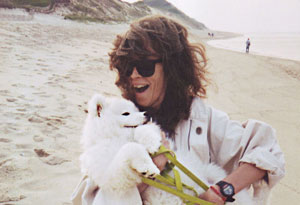Pack of Two

Gail and Clementine at the beach on Cape Cod, 1995.
Gail Caldwell and Caroline Knapp were athletes, sisterly competitors, best friends. Then Caroline died, leaving Gail to untangle their intangible, spooky bond.
I can still see her standing on the shore, a towel around her neck and a postworkout cigarette in her hand—half Gidget and half Splendid Splinter, her rower's arms in defiant contrast to the awful pink bathing suit she'd found somewhere. It was the summer of 1997, and Caroline and I had decided to swap sports: I would give her swimming lessons and she would teach me how to row. This arrangement explained why I was crouched in my closest friend's needle-thin racing shell, 12 inches across at its widest span, looking less like a rower than a drunken spider. We were on New Hampshire's Chocorua Lake, a pristine mile-long body of water near the White Mountains, and the only other person there to watch my exploits was our friend Tom, who was with us on vacation."Excellent!" Caroline called out to me every time I made the slightest maneuver, however feeble; I was clinging to the oars with a white-knuckled grip. At 37, Caroline had been rowing for more than a decade; I was nearly nine years older, a lifelong swimmer, and figured I still had the physical wherewithal to grasp the basics of a scull upon the water. But as much as I longed to imitate Caroline, whose stroke had the precision of a metronome, I hadn't realized that merely sitting in the boat would feel as unstable as balancing on a floating leaf. How had I let her talk me into this?
Novice scullers usually learn in a boat twice the width and weight of Caroline's Van Dusen; later, she confessed that she couldn't wait to see me flip. But poised there on water's edge, hollering instructions, she was all steely enthusiasm. And she might as well have been timing my success, fleeting as it was, with a stopwatch. The oars my only leverage, I started listing toward the water and then froze at a precarious 60-degree angle, held there more by paralysis than by any sense of balance. Tom was belly-laughing from the dock; the farther I tipped, the harder he laughed.
"I'm going in!" I cried.
"No, you're not," said Caroline, her face now as deadpan as a coach's in a losing season. "No, you're not. Keep your hands together. Stay still—don't look at the water, look at your hands. Now look at me." The voice consoled and instructed long enough for me to straighten into position, and I managed five or six strokes across flat water before I went flying out of the boat and into the lake. By the time I came up, a few seconds later and ten yards out, Caroline was laughing, and I had been given a glimpse of the rapture.
We had gone to Chocorua for the month of August after Tom had placed an ad for a summer rental: "Three writers with dogs seek house near water and hiking trails." The result of his search was a ramshackle 19th-century farmhouse that we would return to for years. Surrounded by rolling meadows, the place had everything we could have wanted: cavernous rooms with old quilts and spinning wheels, a camp kitchen and massive stone fireplace, tall windows that looked out on the White Mountains. The lake was a few hundred yards away. Mornings and some evenings, Caroline and I would leave the dogs and walk down to the water, where she rowed the length of the lake and I swam its perimeter. I was the otter and she was the dragonfly, and I'd stop every so often to watch her flight, back and forth for six certain miles. Sometimes she pulled over into the marshes so that she could scrutinize my free-form flip turns in the water. We had been friends for a couple of years by then, and we shared the competitive spirit that belongs to sisters, or adolescent girls—each of us wanted whatever prowess the other possessed.
I have a photograph from another one of those summers at Chocorua, framing the backs of my dog and Caroline's, Clementine and Lucille, who are silhouetted in the window seat and looking outside. It is the classic dog photo, capturing vigilance and loyalty: two tails resting side by side, two animals glued to their post. What I didn't realize for years is that in the middle distance of the picture, you can make out the smallest of figures—an outline of Caroline and me walking down the hill. We must have been on our way to the lake, and the dogs, by now familiar with our routine, had assumed their positions.
I discovered this image the year after she died, and it has always seemed like a clue in a painting—a secret garden revealed only after it is gone. Chocorua itself has taken on an idyllic glow: I remember the night Caroline nearly beat Tom at arm wrestling; the mouse that sent me onto the dining room table while she howled with laughter; the Best Camper awards we instituted (and that she always won). I have glossed over the mosquitoes, the day Caroline got angry when I left her in a slower-moving kayak and rowed off into the fog alone. Like most memories tinged with finality, mine carry a physical weight of sadness. What they never tell you about grief is that missing someone is the simple part.
Photo: Matthew Gilbert



